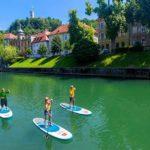The former Soviet Republics offer everything from beautifully preserved historic sites to contemporary neighborhoods.
Although they’ve been independent again for more than a quarter century, the Baltic countries of Estonia, Latvia, and Lithuania still often get lumped together in travelers’ minds—until they actually visit. The former Soviet Republics are actually quite distinct, offering everything from beautifully preserved historic sites to contemporary neighborhoods. Here are our top picks for things to do throughout the region.
Top Picks for You
Festivals
Baltic folks are nothing if not music lovers, and a number of annual festivals throughout the region make it easy for travelers to join locals to enjoy the greatest local and international talent. In Lithuania’s capital the super-hip Loftas Fest, part of the larger annual Vilnius City Fiesta, converts a massive industrial complex into a weekend-long music and arts festival in early September. In Latvia, Positivus, the biggest music and arts festival in the Baltics, happens over a three-day weekend every July in the otherwise modest northern seaside town of Salacgrīva. In Estonia, which prides itself on its Singing Revolution, the capital hosts Tallinn Music Week every spring, with some 200 acts from a variety of genres.
Tallinn
Tallinn‘s well-preserved and easily walkable Old Town dates from the 13th century, when invading Danes began building what became one of the region’s most important trade hubs (as part of the Hanseatic League) in the Late Middle Ages and early modern era. The picture-perfect Estonian capital was spared serious damage during World War II, and Tallinn’s Old Town is now a UNESCO World Heritage Site, centered on the ever-bustling Town Hall Square. Pop into historic St. Nicholas Church, which showcases centuries of ecclesiastical works from the collections of the Art Museum of Estonia. Up on Toompea Hill is the medieval St. Mary’s Cathedral, as well as the more recent Russian Orthodox Alexander Nevsky Cathedral. For a quick course in Tallinn history, visit the Kiek in de Kök tower, part of Old Town’s original fortifications.
Recommended Fodor’s Video
Manors
In Estonia and Latvia, Germanic nobles held sway over the countryside for centuries, and left behind numerous gorgeous manors spread across both nations, many of which have been converted into luxurious hotels. Two standout properties in Estonia are the Pädaste Manor and Spa on Muhu Island, which dates from the 14th century and is now the only five-star property in the country outside of Tallinn; and the even older Kau Manor, dating from the 13th century, which was renovated to eclectic perfection by Estonian MP Eerik-Niiles Kross and his American wife, artist Mary Jordan. Next door in Latvia, Mālpils Manor and Liepupe Manor are among the country’s finest.
Hip Neighborhoods
The Baltic countries’ capitals are home to some of the trendiest neighborhoods on the continent. In Vilnius, the offbeat Užupis neighborhood declared itself an independent republic in 1997, and has its own tongue-in-cheek constitution. Tallinn’s Kalamaja neighborhood, once home to fishermen’s families and later a restricted Soviet military area, now fills its quaint wooden houses with cool shops and cafés. In Riga, Miera Iela (or “Peace Street”) is the heart of the city’s booming bohemian quarter, and has been pegged by some as the top hipster neighborhood in all of Europe.
Rundale Palace
Built on the site of an earlier medieval castle, Rundāle Palace was designed by famed royal mansion architect Bartolomeo Rastrelli and built over several decades in the mid-18th century. After a mostly tumultuous 20th century, when it was used as a school and a military barracks, the 54-room Rundāle underwent extensive renovations, which were completed in 2014. Today the ornate palace and gardens are among Latvia’s most popular tourist attractions.
KGB Corner House
The Baltic countries were part of the Soviet Union from 1944 to 1991, which included the shadowy back-room terror of the KGB—and accordingly, each of the Baltic capitals now has its own grim but enlightening museum focused on Soviet-era history. In Riga, the sobering KGB Corner House (part of the Museum of Occupation of Latvia) includes a tour of the cells and interrogation cellars used by the all-powerful organization. In Vilnius, Lithuania’s former KGB headquarters and prison are revealed at the Museum of Genocide Victims. Tallinn’s version is a little less dark, but still chilling: on the top floor of the Hotel Viru, visitors can now see the command center where KGB officers once spied on the 20-plus floors of guests below them.
Islands
Of the three Baltic countries, Estonia wins the island contest by a landslide, with a whopping 2,222 of them. Many are small and uninhabited, but quite a few offer a chance for unique excursions. Among the most popular are Saaremaa, Estonia’s largest island, and its sister island Muhu, which are easily accessible and filled with colorful folklore, great nature spots, and beaches. Farther afield is Kihnu, the “women’s island,” where semi-remoteness has helped it preserve a proud and distinct matriarchal culture. Just off the coast of Tallinn is Prangli, an island with only around 150 residents, which has rustic camping accommodations for nature lovers.
100,000 Crosses
After an 1831 uprising against the Russian government, crosses were left by soldiers’ families at this battle site north of the Lithuanian city of Šiauliai—the tradition continued, and the site became known as the Hill of Crosses. During Soviet occupation, the government actively tried to dismantle the site by removing crosses, and it became an important place of pilgrimage for the country’s die-hard Catholics. Adding crosses to the hillside began in earnest again after Lithuanian independence in the early 1990s. The exact number of crosses here is not known—and the number is growing—but it’s estimated that well over 100,000 cover the area, making it a striking sight.
Vilnius
Lithuania’s capital of Vilnius is one of very few major European cities where hot air ballooning is allowed, making this a must during your Baltic visit. Several companies offer rides from the heart of the city that take you over the scenic historic center of Vilnius (a UNESCO World Heritage Site) and onward to the picturesque outskirts and countryside beyond.
Riga Art Nouveau Museum
Latvia’s capital city of Riga experienced extraordinary prosperity at the cusp of the 19th and 20th centuries—just when Art Nouveau architecture was en vogue—and the city bloomed with ornate and eclectic buildings as a result. One of the most prolific architects of the period was Mikhail Eisenstein, father of famed Soviet film director Sergei Eisenstein. The family lived on Alberta Iela, which showcases some of the best of the city’s architectural style, and is home to the must-see Riga Art Nouveau Museum.






